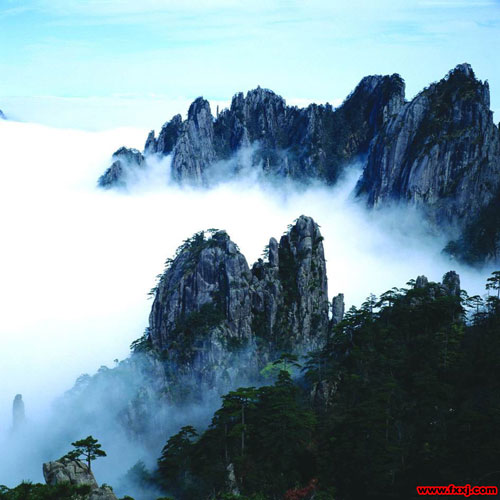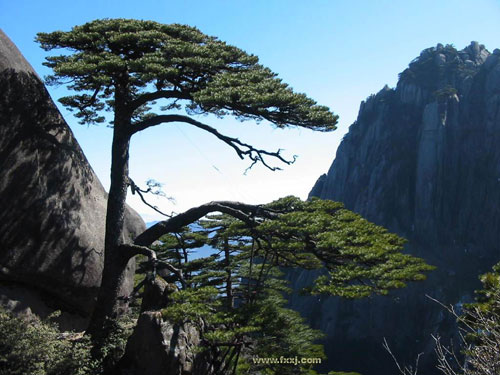| Tools: Save | Print | E-mail | Most Read |
| Not Just for the Mountain |
| Adjust font size: |
Contrary to my expectations, it turns out Huangshan isn't just about its famous mountains. I discovered you can spend a day climbing the mountains and a day descending them, but there's also a day or two's worth of sightseeing in the surrounding area. The main attractions are the Huangshan Grottoes and the ancient villages and if you stay in Tunxi, which we did, you'll be about half an hour to an hour away from both.
But you're probably only reading this to hear about the mountains, so I'll get on and tell you about them first. Personally, I didn't fall in love with them, but that doesn't mean they're not beautiful or worth visiting. Let me explain. Most people climb up the eastern and come down the western steps, because the western side is steeper so it takes longer to reach the more scenic peaks. But we got put on the wrong bus and ended up at the bottom of the western steps rather than eastern ones, as we'd intended. The western steps certainly are more difficult and it also seems a high proportion of the people coming down them feel it necessary to remark to those going up just how much further they have to go. Thanks. As we ascended it wasn't too crowded, which was good: 'excuse me' isn't a phrase the Chinese seem happy using, even when there's a steep path, a fifty foot drop beside you and no rails to hang on to. I'd enjoyed the relatively peaceful climb so I got a shock when we reached the peak. There were so many people it was like stepping in to a beehive. You could barely move, let alone get to the side to see the view.
So we took the cable car off the mountain and I felt a sense of relief at having escaped. I liked the western steps cable car too; it was exciting because you're suspended above the mountain for about twenty minutes as you go down and watching the ground moving below you feel a bit like you're flying. The second time I went to Huangshan, things went much more smoothly, give or take the rain which led to us queuing for two hours to get the cable car up to the eastern steps. However, once we reached the top, the terrain was much easier and the views were vastly improved because the eastern cable car takes you higher than the western one. There were the low clouds you see in pictures and more scenic spots from which to look out over the jagged, pine tree-clad mountains. Wandering away from the main peaks we found a few rarely explored paths too. Getting up to see the sunrise over the mountains is also an experience 100% worth having. The hotels supply you with big waterproof jackets (one size fits all, apparently) and little signs in the lobby let you know what time to expect the sun.
Leave your hotel at least half an hour before though, depending on where you want to see it rise, or you'll arrive to find all the best spots have been taken and everyone else is clamouring to balance precariously on other rocks. So that's the mountain bit. The Huangshan Grottoes were surprisingly different - and that's coming from someone who's seen their fair share of Chinese caves. They're unique because unlike most caves, which are formed by water erosion, these ones are man-made. This gives them an air of mystery, as no one knows why they were created or where they put 200,000 cubic metres of rock removed to form them is now. Inside, the caves are like giant stone rooms and you can still see the chisel marks on the 'walls' and 'ceilings.' I'd never seen anything like it. The caves are inside a park-like area on the far side of a large suspension bridge. Winding your way up and down a series of steps through the park's trees and bushes dotted with brightly coloured flowers is a welcome relief from the cold, dark interior of each cave. You can also take a stroll along the river or ride a bamboo raft for only 10rmb. Before you cross the bridge there's the opportunity to go for a short horse ride or try your hand at archery too. Visit in the morning though, as the area became more crowded in the afternoon when tour groups returning from a night in the mountains started to arrive. In my opinion the ancient villages are the real must-see though, as they're such a contrast to Need to know: The
Need to go: The mountains, although a difficult to climb (assuming you take the steps), are a must. There are steps up to the peaks and then more steps as you move from one peak to the next. Be careful as you come down, especially if you have big feet ¨C the steps aren't very wide and there are no handrails. There are two main routes up, the western steps and the eastern steps. The western steps are much harder and it will take you 6-7 hours to reach the most scenic spots on foot. The Yuping cable car will take you half way, to the The Huangshan Grottoes are strangely engaging. Unlike other caves in Ancient Villages can be a little run down but most are worth a look. It's nice to imagine how it might once have looked when the Ming and Qing buildings were new. The surrounding countryside is also an interesting alternative to the city. Xidi and Hongcun villages are the most well known, but there are others too. The entry fees vary (the most expensive are 80rmb) and some need a passport to obtain an entry permit. Students can get a discount. What to eat and where: Huangshan (Hui) cuisine features things such as shiji, a kind of frog or toad living in mountain brooks. The shiji is cooked with a sauce of ham and mushroom in a bamboo steamer. The taste is fresh, tender and refreshing. There's also stewed shi'er (a kind of fungus) and chicken or shadi mati turtle (big turtles are slowly stewed with ham). Laojie Diyi Lou ( Huangshan (Hui) snacks include xi ke huang (yellow crab shell). It actually doesn't have crab in it - it's made from chunky vegetables and fresh fatty meat cooked in a sesame bun. It looks like a yellow crab shell when it's cooked though, hence the name. Climbing the mountain it's best to bring your own snacks or a light lunch, as food along the way is quite expensive and restaurants are rare. On top of the mountain you'll probably end up eating in your hotel, as that's where most of the restaurants are. They serve a wide variety of Chinese cuisine and occasionally western food too. The Shilin Grand Hotel is the best place in the mountains to try traditional Hui cuisine. Nightlife: Early nights are really the done thing. After a day climbing the mountains, you may not feel up to any nightlife. There are no clubs at the top of the mountains anyway, although most of the hotels have bars and some have KTV. Massages and spas are available until late in the evening but if you're set to climb the mountain the next day, an early night is strongly recommended! If you must, there are the usual internet cafes, KTV joints and tea houses in Tunxi. Yilin Ge tea house on Final thought: Take plenty of water with you as it gets very expensive the further up the mountains you go. Good shoes, suntan lotion and a waterproof jacket are also a must. Don't forget that the any scenic spot you go to will be shared with hundreds of other tourists too. (smartshanghai.com June 21, 2007)
|
| Tools: Save | Print | E-mail | Most Read |
 |
| Related Stories |
|
Product Directory China Search |
Country Search Hot Buys |


